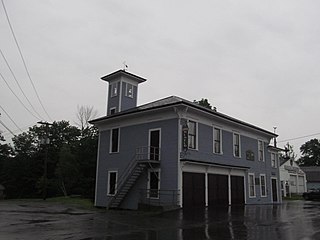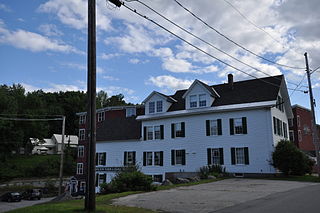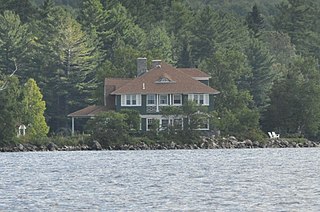
The John Whipple House is a historic colonial house at 1 South Green in Ipswich, Massachusetts. Built in the seventeenth century, the house has been open to the public as a museum since 1899 and was the subject of some of the earliest attempts at the preservation of colonial houses. It was designated a National Historic Landmark in 1960, one of the earliest properties to receive that honor.

The Robert Bacon House is a historic house at 6 Mystic Valley Parkway in Winchester, Massachusetts. Built about 1830, it is one of the town's only surviving examples of high-style transitional Federal/Greek Revival styling. It was built for a local businessman whose nearby mills were major employers of the period. The house was listed on the National Register of Historic Places in 1989.

Camp Hammond is an historic house at 74 Main Street in Yarmouth, Maine. Built in 1889, this large Shingle style is notable for its method of construction, which used techniques more typically applied to industrial mill construction in a residential setting to minimize the spread of fire. George W. Hammond, one of its architects, was owner of the nearby Forest Paper Company. The house was listed on the National Register of Historic Places in 1979.

The Monson Historical Society Museum is located on Main Street in the center of Monson, Maine. It is housed in a former municipal building, built in 1889 to house firefighting equipment and a fraternal lodge, and listed on the National Register of Historic Places as Monson Engine House (Former) on August 5, 2005, as one of a small number of surviving 19th-century fire stations in rural interior Maine. The museum is open on Saturdays in the summer, showing items of local historical interest.

The Bass Boarding House is an historic house on Canal Street in Wilton, Maine, United States. It was built in 1860s, and adapted for use as worker housing for G.H. Bass & Co., whose former factory building stands next door. The building, one of a few that survive in Wilton that were adapted in this way, was added to the National Register of Historic Places in 1988. It now houses the Wilton Historical Society's Wilton Farm and Home Museum.

The Michael Reade House is a historic house at 43 Main Street in Dover, New Hampshire. Built about 1780 for a prominent local merchant, it is one of the city's few surviving 18th-century buildings. It was listed on the National Register of Historic Places in 1980. It now houses professional offices.

The Nathaniel and Elizabeth Bennett House, also locally known as the Cedarbrook Farm, is a historic house and farm property on the west side of Crockett Ridge Road in Norway, Maine, United States. The property is distinctive for its well-preserved Federal style house, including one room that contains an unusual form of stencil painting on its walls. It also has historic association with Don Carlos Seitz, the editor of the New York World, who operated a gentleman's farm on the property. It was listed on the National Register of Historic Places in 1996.

The Osgood Family House is a historic house on Main Street in Fryeburg, Maine. Built c. 1810, this two-story structure is one of the town's least-altered and best-preserved Federal style houses. It was probably built by Henry Young Brown Osgood, and remained in the Osgood family until 1940. It was listed on the National Register of Historic Places in 1990. It presently houses a law office.

The Breakwater is a historic sporting lodge on the Mount Kineo peninsula of Moosehead Lake in central Maine. Built in 1909, it is an architecturally sophisticated example of a sporting lodge, exhibiting Shingle style and Italianate features. It was designed by Howard G. Chamberlain, a New York City architect, with funding from the nearby Mount Kineo Resort and the Moosehead Yacht Club. It was one of the centerpieces of central Maine's most successful summer resort, and was listed on the National Register of Historic Places in 2002.
The Brown House is a historic house on High Street in Brownville, Maine, United States. This two-story wood-frame house was built in 1815 by Francis Brown, for whom the town is named. It is architecturally distinctive for a period suspended ceiling on the second floor. The house was listed on the National Register of Historic Places in 1985.
The Burgess House is a historic house on Burgess Road, just east of Austin Road in Sebec, Maine, United States. The oldest portion of this wood-frame house dates to about 1816, and was built by Ichabod Young, who erected the first fulling mill in Piscataquis County. The house is most remarkable for its high-quality interior woodwork, and for the artwork on the walls of several of its rooms, which includes paintings by Rufus Porter and stencilwork by Moses Eaton, Jr., two noted itinerant artists of the early-to-mid 19th century. The house was listed on the National Register of Historic Places in 1978.

Sangerville Town Hall is located at 1 Town Hall Lane in the village center of Sangerville, Maine. Built in 1902, it is one of the rural community's most sophisticated architectural buildings. It was designed and built by a local contractor, and has well-proportioned Colonial Revival features. It was listed on the National Register of Historic Places in 1991.
The Slate House is an architecturally distinctive house at 123 Church Street in Brownville, Maine. Built c. 1860, it is the only known house to have foundations and wall exteriors fashioned entirely out of slate. It was built by the Brownville and Piscataquis Slate Company, a local quarrying operation, for its superintendent, and is believed to be unique within New England for the use of material and level of Italianate styling it presents. It was listed on the National Register of Historic Places in 1995.
The Straw House was a historic house, most recently a bed and breakfast inn called the Trebor Mansion Inn, at 11A Golda Court in Guilford, Maine. The elegant Queen Anne Victorian was built c. 1832, and extensively altered in the 1880s by David Straw to achieve its present appearance. An electrical fire in 2004 did extensive damage to the building, but it was largely restored to its 1880s appearance. Its walls feature artwork by the itinerant 19th-century artist Moses Eaton. The house was listed on the National Register of Historic Places in 1982. It was destroyed by fire in 2019, and was delisted in 2020.

The Tufts House is a historic house on United States Route 2 in Farmington, Maine. Built in 1810, it is one of the few brick buildings of the period in the region, and is a little-altered example of fine Federal style architecture. The house was listed on the National Register of Historic Places in 1979.

The Robert Rose Tavern is a historic house and former tavern at 298 Long Sands Road in York, Maine. Built in the 1750s using elements of a house built in 1680, it is one of the oldest surviving public hostelries in the state. The original house was built by John Banks, one of York's early settlers, and the tavern was built by a prominent local businessman. Now a private residence, the house was listed on the National Register of Historic Places in 1975.

The Cushing and Hannah Prince House is a historic house at 189 Greely Road in Yarmouth, Maine. Built in 1785 and substantially remodeled about 1830, it is a fine local example of a rural Federal period farmhouse with Greek Revival features. It was listed on the National Register of Historic Places in 1999.

The John and Maria Webb House is an historic house at 121 Main Street in the center of Bridgton, Maine, United States. Built in the first half of the 19th century, it is a rare surviving residential property on the town's main street that was never adapted for commercial use. It was listed on the National Register of Historic Places in 2013.

Parson's Bend is a historic farm property on Nelson Street in Alna, Maine. Built about 1800, the farmhouse is a well-preserved and idiosyncratic Georgian-Federal style Cape house. It was listed on the National Register of Historic Places in 2005.

The Laura Richards House is a historic house at 3 Dennis Street in Gardiner, Maine. Built about 1810, it is a fine local example of Federal period architecture. It is primarily significant as the home of Pulitzer Prize-winning author Laura E. Richards during the majority of her writing career. It was listed on the National Register of Historic Places in 1979.


















